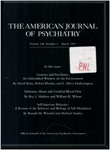Seasonality and affective illness
Abstract
The authors review what has been learned about the causes, symptoms, and treatments of seasonal affective disorder and discuss its relevance to affective illness in general. They point out that seasonal and environmental influences on depression have been themes in writings on affective illness for more than 2,000 years and that there has been a resurgence of interest during the past decade. There appear to be two primary, opposite seasonal patterns of annual depression--winter depression and summer depression--with opposite vegetative symptoms. Seasonal affective disorder is not uncommon. It is important to identify patients with winter depression because they respond to a specific treatment, phototherapy.
Access content
To read the fulltext, please use one of the options below to sign in or purchase access.- Personal login
- Institutional Login
- Sign in via OpenAthens
- Register for access
-
Please login/register if you wish to pair your device and check access availability.
Not a subscriber?
PsychiatryOnline subscription options offer access to the DSM-5 library, books, journals, CME, and patient resources. This all-in-one virtual library provides psychiatrists and mental health professionals with key resources for diagnosis, treatment, research, and professional development.
Need more help? PsychiatryOnline Customer Service may be reached by emailing [email protected] or by calling 800-368-5777 (in the U.S.) or 703-907-7322 (outside the U.S.).



